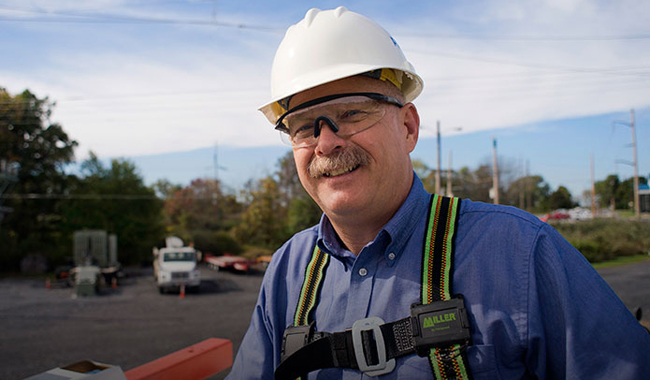
Feb 23, 2015 | Safety and Security
This is a guest post written by Jacque Creamer of PPL Electric Utilities’ Health and Safety group. He also is chief of the Fogelsville Volunteer Fire Department in Lehigh County.
Electrical hazards exist in some form for nearly all of us.
Whether you’re a homeowner working around your yard, a contractor on a job site, or a first responder out on a call, you need to know what to do to stay safe.
Hazards multiply for anyone involved in cleanup and recovery efforts following major disasters and storms. One particular danger exists around downed or low-hanging electrical wires.
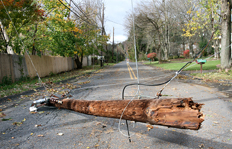
Always consider any downed line to be energized.
Above all else, always consider any downed line to be energized. Be cautious. If you notice downed wires or damaged electrical equipment, contact your utility company. For PPL Electric Utilities, that’s 1-800-DIAL-PPL.
Remember: Electrical circuits don’t always turn off when a power line falls into a tree or onto the ground. Even if they are not sparking or humming, downed power lines can kill you if you touch them. Even the ground nearby can be energized.
Downed wires can energize other objects, including fences, water pipes, bushes and trees, buildings and phone and cable wires. Even manhole covers and reinforcement bars in pavement can become energized by downed wires. During storms, wind-blown objects such as canopies, aluminum roofs, siding, sheds, etc., can also be energized by downed wires.
Here are some rules to live by:
- Do NOT assume a downed wire is safe simply because it is on the ground or is not sparking. Everything should be considered energized until tested to be otherwise.
- Do NOT assume that all coated, weatherproof or insulated wire is just telephone, television or fiber-optic cable.
- Never go near a downed electric power line. Always assume that it is energized. Touching it could be fatal.
- Electricity can spread outward through the ground in a circular pattern from the point of contact. As you move away from the center, large differences in voltages can be created.
- Never drive over downed power lines. Assume that they are energized. Even if downed lines are not energized, they can become entangled in your equipment or vehicle.
- If contact is made with an energized power line while you are in a vehicle, remain calm and do not get out unless the vehicle is on fire. If possible, call for help.
- If you must exit any equipment or vehicle because of fire or other safety reasons, try to jump completely clear, making sure that you do not touch the equipment and the ground at the same time. Land with both feet together and shuffle away in small steps to minimize the path of electric current and avoid electrical shock. Be careful to maintain your balance.
Always stay away, and call 911 and your local utility company. Safety is everyone’s responsibility!
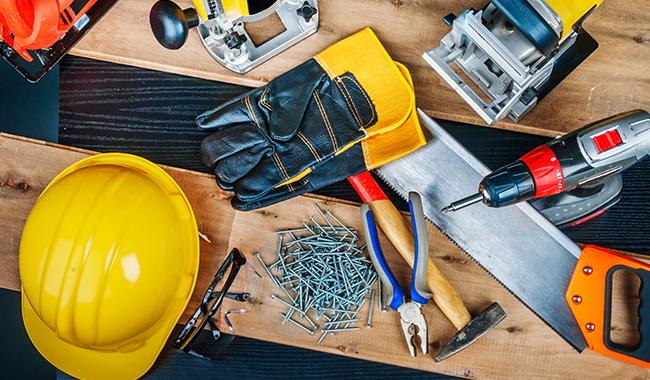
Dec 22, 2014 | Safety and Security
If you received a power tool over the holidays, please use it the right way. Following these great guidelines from the Electrical Safety Foundation International will help you complete your projects the best way — the safe way.
- Use ground fault circuit interrupters (GFCIs) with every power tool to protect against electric shocks.
- When working with electricity, use tools with insulated grips to avoid shocks.
- Always plug power tools into a grounded outlet, unless the tools are double-insulated.
- Never use power tools near power lines or water pipes.
- If a power tool trips a safety device like a GFCI outlet, take the tool to a repair center authorized by the manufacturer.
- Don’t use power tools without the proper guards.
- Don’t use power tools with an extension cord longer than 100 feet.
- Always use appropriate personal protective gear
- Use extreme caution when cutting or drilling into walls with electrical wires or water pipes.
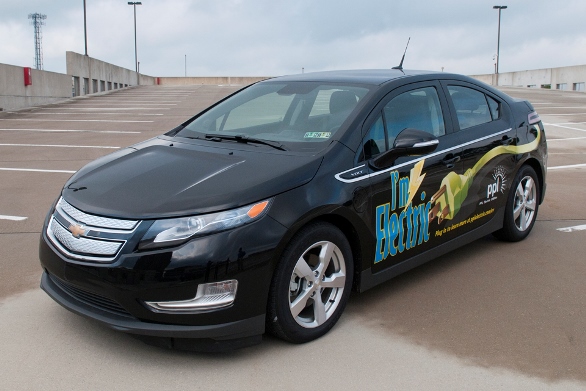
Nov 19, 2014 | Energy Future
We were among the utilities that received a shout out at the White House on Nov. 18 for helping advance the electric vehicle market.
With U.S. Secretary of Energy Ernest Moniz, who cited the industry’s progress and commitment to electric transportation, the Edison Electric Institute (EEI) announced that 73 utilities have committed to spend at least 5 percent of their annual fleet acquisition budgets on plug-in electric vehicles.
For our part toward achieving that goal, next year we plan to purchase 15 Chevrolet Volt plug-in hybrid electric vehicles. We’ve been using three Chevy Volts since the summer of 2011 as part of an industry study to determine the effect of electric cars on the grid.
In September, we were awarded a $116,100 state grant toward the purchase of the Volts, which will be used for field visits and travel between work locations. They will replace 15 older gas-powered cars in our fleet.
The national recognition that the we and our industry peers received is appreciated as we continue our support for the growth of plug-in electric vehicles. We’re using them as part of our business and at the same time showing the public that electric cars are a viable and environmentally conscious means of transportation.
We were one of about 25 utilities in the research project led by the Electric Power Research Institute and General Motors that studied the effect of electric vehicles on the grid.
That study helped us determine that our infrastructure and delivery system can handle the commercial growth of these vehicles.
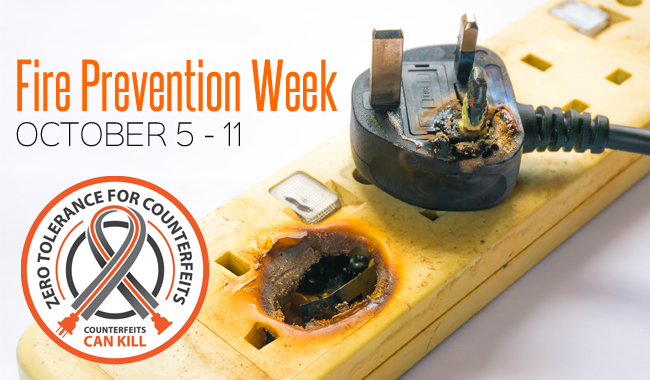
Oct 6, 2014 | Safety and Security
Did you know that 2/3 of deaths from fires happen in homes with no smoke alarms or where smoke alarms aren’t working? This week is Fire Prevention Week, and we want to share tips to help keep you and your family safe.
Smoke detectors can save lives, but only if they’re working properly. The Electrical Safety Foundation International recommends that you:
- Test the batteries in your smoke detectors monthly, and replace the batteries at least yearly.
- Replace the smoke detector itself every 10 years.
- Install at least one smoke detector for every floor of your house, outside each sleeping area and in every bedroom.
Here are some other tips from ESFI:
Avoid counterfeit electrical products – Counterfeit electrical products are a growing problem. ESFI reports that over the past decade, U.S. seizures of counterfeit products have increased more than 325 percent. Cheap cell phone chargers may look like a bargain, but they could damage your phone or cause a fire. Never buy electrical products that don’t have the mark of a nationally recognized testing laboratory such as UL, CSA or ETL.
Install AFCI Outlets – Arc fault circuit interrupters are advanced outlets that shut down power when unsafe conditions are detected. They can reduce the chance of an electrical fire.
Safely use extension cords – Don’t overload an outlet or extension cord, and never use one that has been damaged. More than 3,000 home fires are caused each year by extension cords, according to ESFI.
Pay attention to switches and outlets – Are your switches and outlets working properly? Do they make crackling, buzzing or sizzling sounds? If you notice anything unusual about your switches and outlets, contact a qualified electrician immediately to have them inspected.
Stay safe in the kitchen – Cooking is a leading cause of home fires. Never leave a child alone when you’re cooking or when an electrical appliance is within reach. Don’t leave the stove or toaster oven unattended.
Maintain your clothes dryers – Clean the lint filter after each use, and be sure to keep your vents clear of lint buildup. The lint will reduce the efficiency of your dryer, but more importantly, could cause a fire.
Be cautious when using space heaters – Keep space heaters at least 3 feet away from flammable material such as furniture and blankets. Avoid using extension cords if possible and never leave space heaters turned on while unattended.
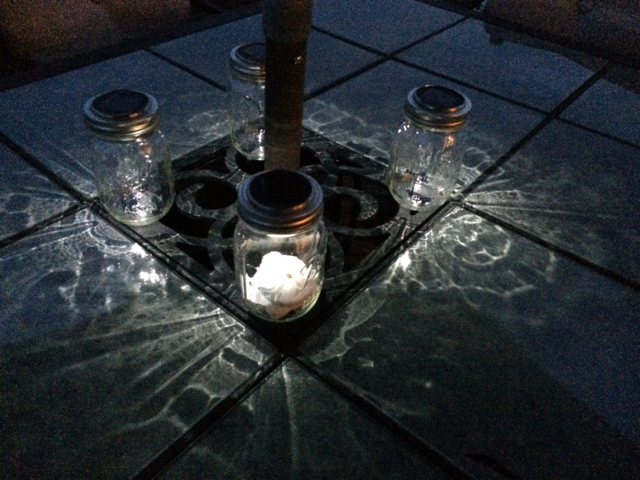
Aug 29, 2014 | Energy Efficiency
Summer is a great time to entertain your family and friends outdoors. My family spends a lot of time outdoors, and I’m all for taking the family fun outside to reduce our energy use and beautifying the backyard and patio. Upgrading to energy-efficient outdoor lighting products can make your home look great and help you save energy all year long.
I’m a DIYer to the core. I always seem to have my hand in some sort of home improvement project. To be honest, sometimes it feels like the list never ends. You check one project off your list, and you add two more. The good news is that these projects are fun and can make your house look great.
This year I had a few extra “to-do’s” on my list. As we were sprucing up the landscaping I decided this was the year the outdoor lighting needed an upgrade. Let me just say it was well past-due!
Off we went to the local home improvement store. You can get lost in those lighting aisles. As we browsed the aisles we found all sorts of things, from energy-efficient solar pathway and landscape lighting to ENERGY STAR® qualified fixtures, LED light bulbs and even exterior lights with motion sensors.
Based on what we had at our home, I opted for new LED lighting. Did you know that energy-efficient ENERGY STAR® LED bulbs use up to 75 percent less energy and last up to 20 times longer than traditional incandescent bulbs. (That’s a pretty big deal.)
But I wasn’t finished just yet. While some of the lights have motion detectors, I also wanted to put them on a timer. It seems we’re always flipping the light on for company and leaving it on … all night long. Those days (and nights) were about to end. We installed the perfect outdoor timer for us. We were able to adjust the dusk/dawn time settings. Easy! We’ll just have to remember to adjust in the fall when it gets a darker a bit earlier.
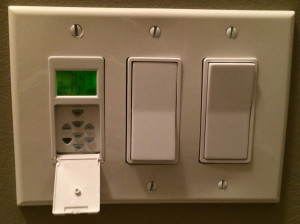
And who doesn’t want to have a beautiful patio? The next thing on my list was to break out these super cute Mason jar solar light accents.
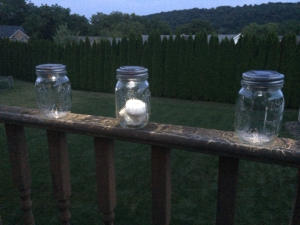
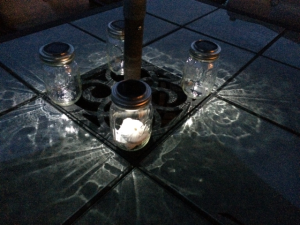
They recharge daily with the sun and can be customized by adding a little extra decoration to the outside of the jar or by filling them. I filled mine with sea shells, but sand and a little flower or gemstones would also look great!
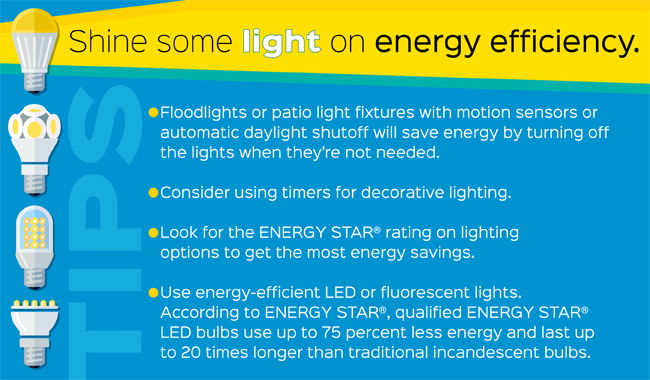
Are you thinking of upgrading your outdoor or patio lighting or have you finished any new projects? We’d love to hear what you’ve done in the comments below










